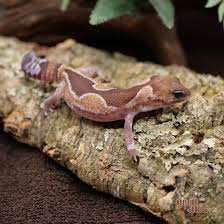GECKO ZULU (Hemitheconyx caudicinctus)
$250.00
Full Description
Here is a complete care guide for the Zulu African Fat-Tailed Gecko (Hemitheconyx caudicinctus), a striking and relatively rare morph prized for its bold, high-contrast markings and genetic uniqueness.
Zulu Fat-Tailed Gecko Care Guide
Morph Overview
| Trait | Description |
|---|---|
| Common Name | Zulu Gecko, Zulu Fat-Tailed Gecko |
| Scientific Name | Hemitheconyx caudicinctus |
| Morph Type | Recessive (Zulu) |
| Appearance | Unique dorsal “zulu mask”-like patterning with strong striping or zig-zag shapes |
| Experience Level | Intermediate (rare morph, best for informed keepers) |
Size & Lifespan
| Feature | Typical Range |
|---|---|
| Adult Size | 7–9 inches (18–23 cm) |
| Adult Weight | 45–75 grams |
| Lifespan | 15–20+ years in captivity |
Enclosure Setup
Enclosure Size
| Gecko Stage | Minimum Size |
|---|---|
| Hatchling | 10–15 gallons |
| Adult | 20-gallon long tank |
Horizontal floor space is critical for ground-dwelling geckos.
Substrate Options
| ✅ Safe Options | ❌ Unsafe Options |
|---|---|
| Paper towels | Loose or calcium sand |
| Reptile carpet | Wood shavings or bark |
| Ceramic/slate tile | Soil with perlite or gravel |
| Bioactive (advanced setups) | Dusty or unstable materials |
️ Temperature & Humidity
| Zone | Fahrenheit | Celsius |
|---|---|---|
| Warm Side | 88–92°F | 31–33°C |
| Cool Side | 75–80°F | 24–27°C |
| Nighttime | 70–75°F | 21–24°C |
| Humidity | 50–70% | With humid hide required |
Use an under-tank heater (UTH) with a thermostat.
Provide a humid hide using damp sphagnum moss or paper towel.
Monitor temperatures and humidity with digital gauges.
Lighting
-
UVB lighting is optional, but a low-output 2–5% UVB can promote natural vitamin D3 synthesis.
-
Maintain a 12-hour light/dark cycle.
-
Avoid excessive brightness—these geckos are crepuscular (active during dawn/dusk).
️ Hides & Tank Decor
| Hide Type | Purpose |
|---|---|
| Warm Hide | Digestion and basking |
| Cool Hide | Thermoregulation and retreat |
| Humid Hide | Hydration and shedding |
| Decor | Rocks, logs, fake plants |
Always secure decor to avoid collapses or injury.
Diet & Feeding
Staple Insects
| Insect | Notes |
|---|---|
| Crickets | Encourages hunting behavior |
| Dubia Roaches | High in protein, ideal staple |
| Mealworms | Easy to dish-feed |
| BSFL (CalciWorms) | Naturally calcium-rich |
| Waxworms/Superworms | High fat—occasional treat only |
Feeding Schedule
| Gecko Age | Frequency |
|---|---|
| Juvenile | Daily |
| Adult | Every 2–3 days |
Supplements
| Supplement Type | Frequency |
|---|---|
| Calcium (no D3) | Always available |
| Calcium + D3 | 1–2× per week |
| Multivitamin | 1× per week |
✅ Gut-load feeder insects for 24–48 hours before feeding.
Cleaning & Maintenance
| Task | Frequency |
|---|---|
| Spot Clean | Daily |
| Water Refresh | Daily |
| Humid Hide Check | 2–3× weekly |
| Deep Clean | Monthly |
Morph-Specific Notes: Zulu
| Aspect | Note |
|---|---|
| Pattern | Zulu morphs display wild, abstract dorsal markings resembling tribal masks or stripes. Often confused with Patternless Zulus or Stripes in early development. |
| Genetics | Recessive—requires two copies of the gene to express visually. |
| Breeding | Zulu × Zulu = all visual Zulus. Zulu × normal = all hets. Do not confuse with Patternless, as they may appear similar at times. |
| Temperament | Calm, shy initially but handleable with patience. |
Handling Tips
-
Wait 1–2 weeks after introduction before handling
-
Always handle gently and support their body
-
Limit sessions to 5–10 minutes initially
-
Avoid handling during shedding or right after feeding
-
Never grab by the tail—they can drop it
✅ Quick Care Summary
| Care Factor | Details |
|---|---|
| Tank Size | 20-gallon long minimum |
| Heating | 88–92°F warm side |
| Humidity | 50–70% with moist hide |
| Substrate | Tile, paper towel, bioactive |
| Lighting | UVB optional (2–5%) |
| Feeding | Insects + calcium/multivitamins |
| Morph Traits | Recessive; known for bold dorsal “mask” patterns |

